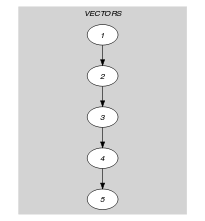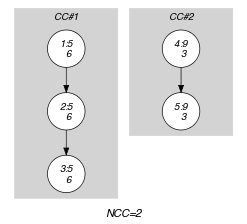5.307. ordered_atmost_nvector
| DESCRIPTION | LINKS | GRAPH |
- Origin
- Constraint
- Synonyms
, , .
- Type
- Arguments
- Restrictions
- Purpose
Enforces the following two conditions:
The number of distinct tuples of values taken by the vectors of the collection is less than or equal to . Two tuples of values and are if and only if there exist an integer such that .
For each pair of consecutive vectors and of the collection we have that is lexicographically less than or equal to . Given two vectors, and of components, and , is lexicographically less than or equal to if and only if or or and is lexicographically less than or equal to .
- Example
-
The constraint holds since:
The collection involves at most 3 distinct tuples of values (i.e., in fact the 2 distinct tuples and ).
The vectors of the collection are sorted in increasing lexicographical order.
- Typical
- Symmetry
can be increased.
- Arg. properties
Contractible wrt. .
- Reformulation
The constraint can be reformulated as a conjunction of a and a constraints.
- See also
-
implied by: ( replaced by ).
implies: , ( of constraint removed).
- Keywords
characteristic of a constraint: vector.
- Arc input(s)
- Arc generator
-
- Arc arity
- Arc constraint(s)
- Graph property(ies)
-
- Arc input(s)
- Arc generator
-
- Arc arity
- Arc constraint(s)
- Graph property(ies)
-
- Graph model
Parts (A) and (B) of Figure 5.307.1 respectively show the initial and final graph of the second graph constraint associated with the Example slot. Since we use the graph property in this second graph constraint, we show the different connected components of the final graph. Each strongly connected component corresponds to a tuple of values that is assigned to some vectors of the collection. The 2 following tuple of values and are used by the vectors of the collection.
Figure 5.307.1. Initial and final graph of the constraint


(a) (b)